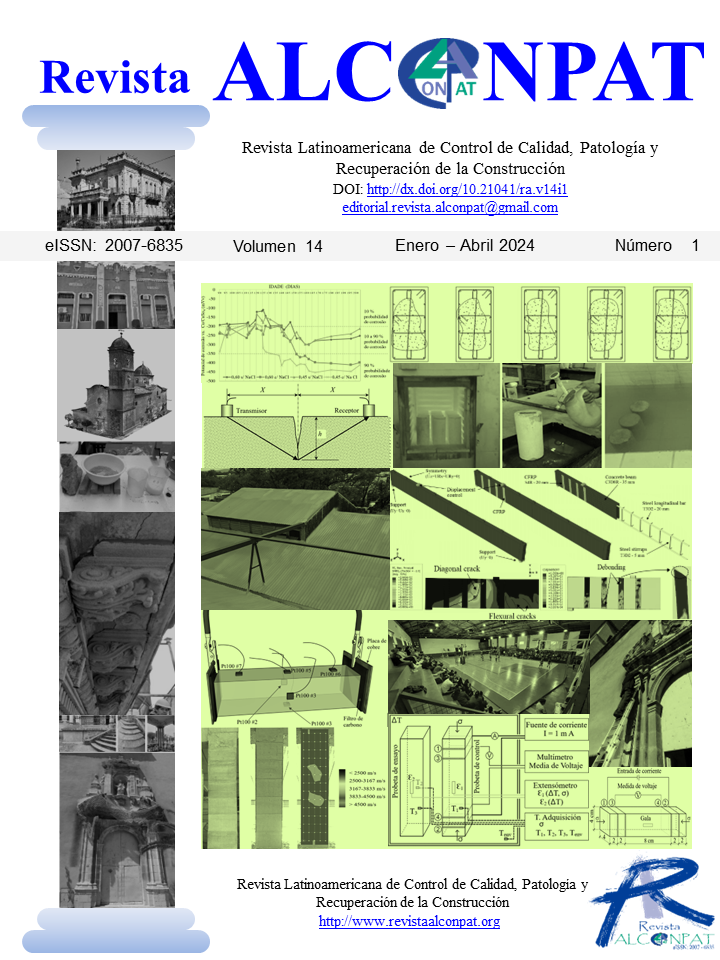Numerical study of RC beams strengthened in shear with CFRP
DOI:
https://doi.org/10.21041/ra.v14i1.687Keywords:
shear; RC beam; strengthening; numerical simulation; debonding.Abstract
The objective of this study is to numerically investigate the strengthening and adhesive interface of a RC beam under shear forces. The study is based on experimental results from the current literature. The strengthening system consisted of carbon fiber reinforced polymers (CFRP) bonded in a U-shape in the critical shear regions. The numerical simulation results were considered efficient. Small differences in ductility were observed between the simulated and experimental beams, which was attributed to the failure to account for the slip of the reinforcing bars. Even with strengthening, fragile collapses are still observed, resulting from the debonding of a portion of the CFRP.
Downloads
References
“ABAQUS 6.12: Analysis User’s Guide” (2012). Vol. 1, 2, 3, 4 e 5. Dassault Systèmes Simulia Corp, Providence, RI, USA.
Al-Osta, M. A. et al (2017), Flexural behavior of reinforced concrete beams strengthened with ultra-high performance fiber reinforced concrete. Construction and Building Materials, v. 134, p. 279–296. http://dx.doi.org/10.1016/j.conbuildmat.2016.12.094
Arcine, M. F. (2020), "Simulação numérica para vigas retangulares em concreto armado reforçadas ao cisalhamento com composito de Fibra de Carbono", Dissertação de Mestrado em Engenharia de Estruturas, Universidade Estadual de Maringá, Maringá.
Arcine, M. F., Menon, N. V. Krahl, P. A. (2023), Numerical and experimental study of the interaction between stirrups and shear strengthening with CFRP in RC beams. Engineering Structures, v. 278. https://doi.org/10.1016/j.engstruct.2022.115514
Baggio, D., Soudki, K., Noël, M. (2014), Strengthening of shear critical RC beams with various FRP systems. Construction and Building Materials, v. 66, p. 634–644. https://doi.org/10.1016/j.conbuildmat.2014.05.097
Benzeggagh, M. L., Kenane, M. (1996), Measurement of mixed-mode delamination fracture toughness of unidirectional glass/epoxy composites with mixed-mode bending apparatus. Composites Science and Technology, v. 56, p. 439–449. https://doi.org/10.1016/0266-3538(96)00005-X
Camanho, P. P., Dávila, C. G. (2002), Mixed-Mode decohesion finite elements for the simulation of delamination in composite materials. Nasa/Tm-2002-211737, p. 42.
Chen, G. M. et al. (2010), Interaction between Steel Stirrups and Shear-Strengthening FRP Strips in RC Beams. Journal of Composites for Construction, v. 14, n. 5, p. 498–509, 2010.
Chi, Y. et al. (2017), Finite element modeling of steel-polypropylene hybrid fiber reinforced concrete using modified concrete damaged plasticity. Engineering Structures, v. 148, p. 23–35. https://doi.org/10.1061/(ASCE)CC.1943-5614.0000120
Colalillo, M. A., Sheikh, S. A. (2014), Behavior of shear-critical reinforced concrete beams strengthened with fiber-reinforced polymer-Experimentation. ACI Structural Journal, v. 111, n. 6, p. 1373–1384. 10.14359/51687035
Demin, W., Fukang, H. (2017), Investigation for plastic damage constitutive models of the concrete material. Procedia Engineering, v. 210, p. 71–78, 2017. https://doi.org/10.1016/j.proeng.2017.11.050
Genikomsou, A. S., Polak, M. A. (2015), Finite element analysis of punching shear of concrete slabs using damaged plasticity model in ABAQUS. Engineering Structures, v. 98, p. 38–48. https://doi.org/10.1016/j.engstruct.2015.04.016
Godat, A. et al. (2007), Numerical Modeling of FRP Shear-Strengthened Reinforced Concrete Beams. Journal of Composites for Construction, v. 11, p. 640–649. https://doi.org/10.1061/(ASCE)1090-0268(2007)11:6(640)
Godat, A., Labossière, P., Neale, K. W. (2012), Numerical investigation of the parameters influencing the behaviour of FRP shear-strengthened beams. Construction and Building Materials, v. 32, p. 90–98. 10.1016/j.conbuildmat.2010.11.110
Guo, Z. (2014), "Principles of reinforced concrete design". Butterworth-Heinemann, Pequim, China, p. 587.
Jumaa, G. B., Yousif, A. R. (2019), Numerical modeling of size effect in shear strength of FRP-reinforced concrete beams. Structures, v. 20, p. 237–254. https://doi.org/10.1016/j.istruc.2019.04.008
Kezmane, A., Boukais, S., Hamizi, M. (2016), Numerical simulation of squat reinforced concrete wall strengthened by FRP composite material. Frontiers of Structural and Civil Engineering, v. 10, n. 4, p. 445–455. https://doi.org/10.1007/s11709-016-0339-9
Lee, J., Fenves, G. L. (1998), Plastic-damage model for cyclic loading of concrete structures. Journal of Engineering Mechanics, v. 124, n. 8, p. 892–900. https://doi.org/10.1061/(ASCE)0733-9399(1998)124:8(892)
Lu, X. Z. et al. (2005), Bond-slip models for FRP sheets/plates bonded to concrete. Engineering Structures, v. 27, n. 6, p. 920–937, 2005. https://doi.org/10.1016/j.engstruct.2005.01.014
Lubliner, J. et al. (1989), A plastic-damage model for concrete. International Journal of Solids and Structures, v. 25, n. 3, p. 299–326. https://doi.org/10.1016/j.engstruct.2005.01.014
Manos, G. C., Theofanous, M., Katakalos, K. (2014), Numerical simulation of the shear behaviour of reinforced concrete rectangular beam specimens with or without FRP-strip shear reinforcement. Advances in Engineering Software, v. 67, p. 47–56. http://dx.doi.org/10.1016/j.advengsoft.2013.08.001
Mansour, W. (2021), Numerical analysis of the shear behavior of FRP-strengthened continuous RC beams having web openings. Engineering Structures, v. 227, p. 111451. https://doi.org/10.1016/j.engstruct.2020
Obaidat, Y. T., Heyden, S., Dahlblom, O. (2010), The effect of CFRP and CFRP/concrete interface models when modelling retrofitted RC beams with FEM. Composite Structures, v. 92, n. 6, p. 1391–1398. https://doi.org/10.1016/j.compstruct.2009.11.008
Pellegrino, C., Modena, C. (2008), An experimentally based an a lytical model for the shear capacity of FRP-strengthened reinforced concrete beams. Mechanics of Composite Materials, v. 44, n. 3, p. 231–245. https://doi.org/10.1007/s11029-008-9016-y
Piggott, M. (2002), "Load bearing fibre composites". 2 ed. Kluwer Academic Publishers, Ontario, Canadá, p. 490.
Risson, A. V. (2016), "Estudo experimental de sistema de ancoragem por cordão de fibra de carbono para vigas reforçadas com PRFC", Master Thesis, Universidade Estadual de Maringá, p. 160.
Shomali, A., Mostofinejad, D., Esfahani, M. R. (2020), Experimental and numerical investigation of shear performance of RC beams strengthened with FRP using grooving method. Journal of Building Engineering, v. 31, p. 101409. https://doi.org/10.1016/j.jobe.2020.101409
Teng, J. et al. (2002), "FRP-strengthened RC Structures". 1st ed. Wiley, Chichester, U.K, p. 272.
Yuan, H. et al. (2004), Full-range behavior of FRP-to-concrete bonded joints. Engineering Structures, v. 26, n. 5, p. 553–565, 2004. https://doi.org/10.1016/j.engstruct.2003.11.006
Zheng, Y. Z. et al. (2020), Experimental investigation and numerical analysis of RC beams shear strengthened with FRP/ECC composite layer. Composite Structures, v. 246, p. 112436.
Published
How to Cite
Issue
Section
License
_______________________________
License in effect from September 2020
You are free to:
- Share — copy and redistribute the material in any medium or format for any purpose, even commercially.
- Adapt — remix, transform, and build upon the material for any purpose, even commercially.
- The licensor cannot revoke these freedoms as long as you follow the license terms.
Under the following terms:
- Attribution — You must give appropriate credit , provide a link to the license, and indicate if changes were made . You may do so in any reasonable manner, but not in any way that suggests the licensor endorses you or your use.
- No additional restrictions — You may not apply legal terms or technological measures that legally restrict others from doing anything the license permits.
Notices:
You do not have to comply with the license for elements of the material in the public domain or where your use is permitted by an applicable exception or limitation .
No warranties are given. The license may not give you all of the permissions necessary for your intended use. For example, other rights such as publicity, privacy, or moral rights may limit how you use the material.





















.png)














